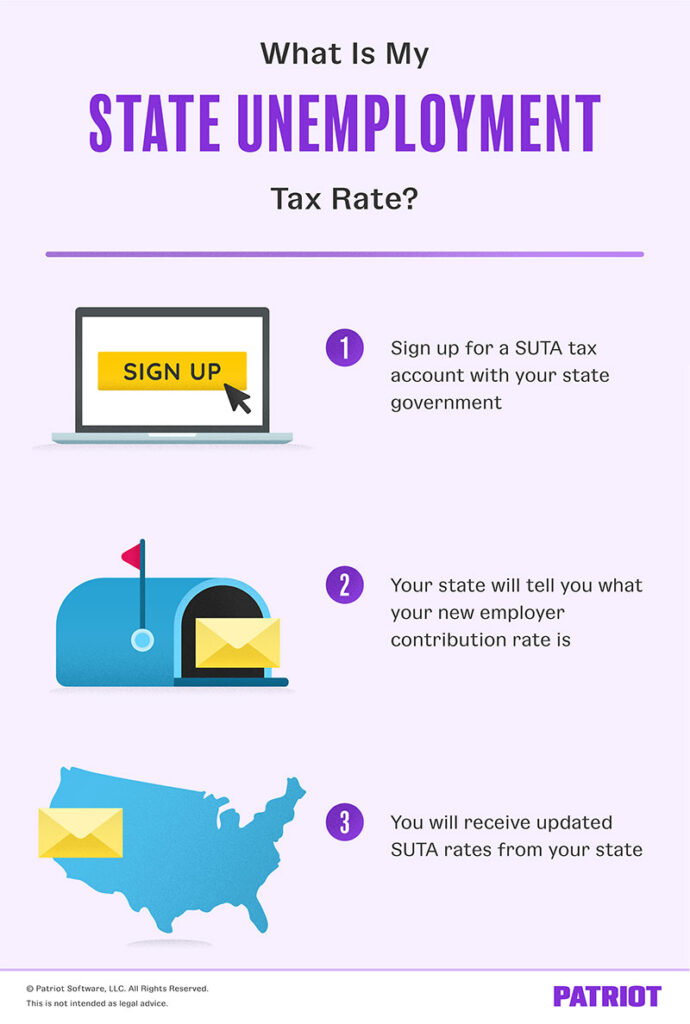Running payroll means staying on top of your employment tax responsibilities. In addition to withholding income and payroll taxes from employee wages, you must contribute employer taxes. Unlike some other taxes, state unemployment taxes do not have a standard rate. Read on to answer, What is my state unemployment tax rate?
About state unemployment tax
If you have employees, you need to know about state unemployment tax and federal unemployment tax. These taxes fund unemployment programs and pay out benefits to employees who lose their jobs through no fault of their own.
Generally, unemployment taxes are employer-only taxes, meaning you do not withhold the tax from employee wages. However, some states (Alaska, New Jersey, and Pennsylvania) require that you withhold additional money from employee wages for state unemployment taxes (SUTA tax).
State unemployment tax is a percentage of an employee’s wages. Each state sets a different range of tax rates. Your tax rate might be based on factors like your industry, how many former employees received unemployment benefits, and experience.
State unemployment taxes are referred to as SUTA tax or state unemployment insurance (SUI). Or, they may be referred to as reemployment taxes (e.g., Florida).
You pay SUTA tax to the state where the work is taking place. If your employees all work in the state your business is located in, you will pay SUTA tax to the state your business is located in. But if your employees work in different states, you will pay SUTA tax to each state an employee works in.
States also set wage bases for unemployment tax. This means you only contribute unemployment tax until the employee earns above a certain amount.
How to get your SUTA tax rate
When you become an employer, you need to begin paying state unemployment tax. To do so, sign up for a SUTA tax account with your state.
You can register as an employer online using your state’s government website. You might also be able to register for an account by mailing a form to your state. Each state has a different process for obtaining an account. Check your state’s government website for more information.
To register for an account, you need to provide information about your business, such as your Employer Identification Number. When you register for an account, you will obtain an employer account number.
Intimidated by the thought of state registration? For state tax registration made simple, try our partner, CorpNet.
Once registered, your state tells you what your SUI rate is. And, your state also tells you what your state’s wage base is.
Many states give newly registered employers a standard new employer rate. The state unemployment insurance rate for new employers varies.
Some states split new employer rates up by construction and non-construction industries. For example, all new employers receive a SUTA rate of 1.25% in Nebraska, and all new construction employers receive a SUTA rate of 5.4% in 2024.
If you live in a state that doesn’t use a standard new employer rate, you must wait for your state to assign you your starting rate.
Your state will eventually change your new employer rate. The amount of time depends on the state. You may receive an updated SUTA tax rate within one year or a few years. Most states send employers a new SUTA tax rate each year.
Generally, states have a range of unemployment tax rates for established employers. Your state will assign you a rate within this range. For example, the SUTA tax rates in Alabama range from 0.20% – 6.8%.

SUI tax rate by state
So, how much is unemployment tax? Here is a list of the non-construction new employer tax rates for each state and Washington D.C. Note that some states require employees to contribute state unemployment tax.
| State | New Employer Tax Rate 2024 | Employer Tax Rate Range 2024 |
|---|---|---|
| Alabama | 2.7% | 0.20% – 6.80% |
| Alaska | Standard rate 1.66% (Alaska employers who do not have a rate use the standard rate) 0.50% employee share | 1.50% – 5.90% (including employer share and employee share of 0.50%) |
| Arizona | 2.0% | 0.05% – 14.03% |
| Arkansas | 2.025% (including 0.125% administrative assessment) | 0.1% – 5% (+ stabilization tax) |
| California | 3.4% | 1.5% – 6.2% |
| Colorado | 3.05% | 0.64% – 8.68% (+ Support Surcharge and Solvency Surcharge) |
| Connecticut | 2.5% | 1.1% – 7.8% |
| Delaware | 1% | 0.3% – 5.6% |
| D.C. | The higher of 2.7% or the average rate of all employer contributions in the preceding year | 1.9% – 7.4% |
| Florida | 2.7% | 0.1% – 5.4% |
| Georgia | 2.7% | 0.04% – 8.1% |
| Hawaii | 3.0% | 0.2% – 5.8% |
| Idaho | 1.231% (including the workforce rate, UI rate, and admin rate) | 0.281% – 5.4% (including the workforce rate, UI rate, and admin rate) |
| Illinois | 3.950% | 0.85% – 9.0% (including a 0.55% fund-building surtax) |
| Indiana | 2.5% | 0.5% – 7.4% |
| Iowa | 1.0% | 0.0% – 7.0% |
| Kansas | 2.7% | 0.16% – 6.0% |
| Kentucky | 2.7% | 0.3% – 9.0% |
| Louisiana | Varies | 0.09% – 6.2% |
| Maine | 2.32% (including the CSSF rate and UPAF rate) | 0.28% – 6.03% |
| Maryland | 2.6% | 0.3% – 7.5% |
| Massachusetts | 1.87% | 0.73% – 11.13% |
| Michigan | 2.7% | 0.06% – 10.3% |
| Minnesota | Varies | Maximum of 9.0% (including a base tax rate of 0.10%) |
| Mississippi | 1.0% (1st year), 1.1% (2nd year), 1.2% (3rd year) | 0.0% – 5.4% |
| Missouri | 1.0% for nonprofits and 2.376% for mining, construction, and all other employers | 0.0% – 9.0% (does not include maximum rate surcharge or contribution rate adjustment) |
| Montana | Varies | 0.00% – 6.12% (plus an AFT rate of 0.18%) |
| Nebraska | 1.25% | 0.0% – 5.4% |
| Nevada | 2.95% | 0.25% – 5.4% |
| New Hampshire | 1.7% (minus any Fund Reduction or Plus any Emergency Power Surcharge in place for the applicable quarter) | 0.1% – 7.5% (including a 0.5% surcharge) |
| New Jersey | 3.1% (including the 0.1175% Workforce Development and Supplemental Workforce Funds) Employee rate of 0.425% (including the 0.0425% Workforce Development and Supplemental Workforce Funds) | 0.6% – 6.4% Employee rate of 0.425% |
| New Mexico | 1.0% or the industry average rate, whichever is greater | 5.4% maximum rate |
| New York | 4.1% (including the subsidiary tax rate of 0.625% and the reemployment tax of 0.075%) | 2.1% – 9.9% (including the RSF tax of 0.075%) |
| North Carolina | 1.0% | 0.06% – 5.76% |
| North Dakota | 1.09% (positive-balanced employers) or 6.08% (negative-balanced employers) | 0.08% – 9.68% |
| Ohio | 2.7% | 0.4% – 10.1% |
| Oklahoma | 1.5% | 0.3% – 9.2% |
| Oregon | 2.4% | 0.9% – 5.4% |
| Pennsylvania | 3.822% | 1.419% – 10.3734% |
| Rhode Island | 1.0% (including the 0.21% Job Development Assessment) | 1.1% – 9.7% |
| South Carolina | 0.41% (including 0.06% Contingency Assessment) | 0.06% – 5.46% (including 0.06% Contingency Assessment) |
| South Dakota | 1.2%, plus 0.55% Investment Fee | 0.0% – 8.8% |
| Tennessee | 2.7% | 0.01% – 10% |
| Texas | 2.7% or the industry average rate, whichever is greater | 0.25% – 6.25% |
| Utah | Varies | 0.3% – 7.3% |
| Vermont | 1.0% (for most employers) | 0.4% – 5.4% |
| Virginia | 2.5% (plus add-ons) | 0.1% – 6.2% |
| Washington | Varies | 1.25% – 8.15% |
| West Virginia | 2.7% (for most employers) | 1.5% – 8.5% |
| Wisconsin | 3.05% for new employers with payroll < $500,000 3.25% for new employers with payroll > $500,000 | 0.0% – 12% |
| Wyoming | Varies | 0.09% – 8.5% |
For some states, this SUTA tax rate includes other taxes. Contact your state for more information on included and additional assessments.
For more state-specific information, use our New Employer Information by State for Payroll page.
How to pay unemployment tax to your state
You must report your SUTA tax liability to your state and make payments. Generally, you need to make quarterly payments. Use your employer account number to report and deposit your SUTA tax liability.
Contact your state for more information about reporting and depositing SUTA tax.
Let Patriot’s payroll services handle your payroll calculations, tax filings, and deposits. We’ll deposit your payroll taxes and file the appropriate forms with federal, state, and local agencies. Get started with a free trial!
This article has been updated from its original publication date of July 16, 2018.
This is not intended as legal advice; for more information, please click here.






